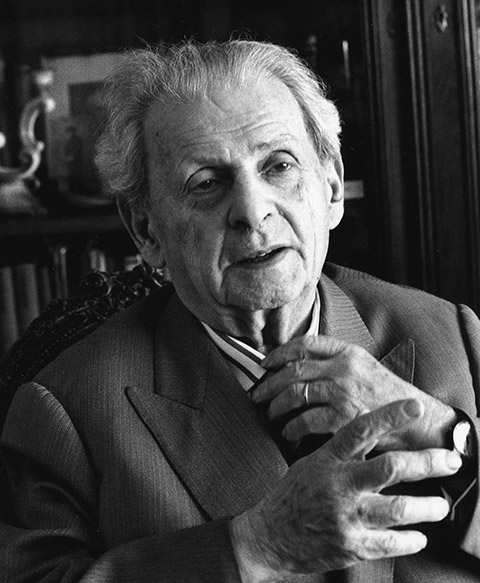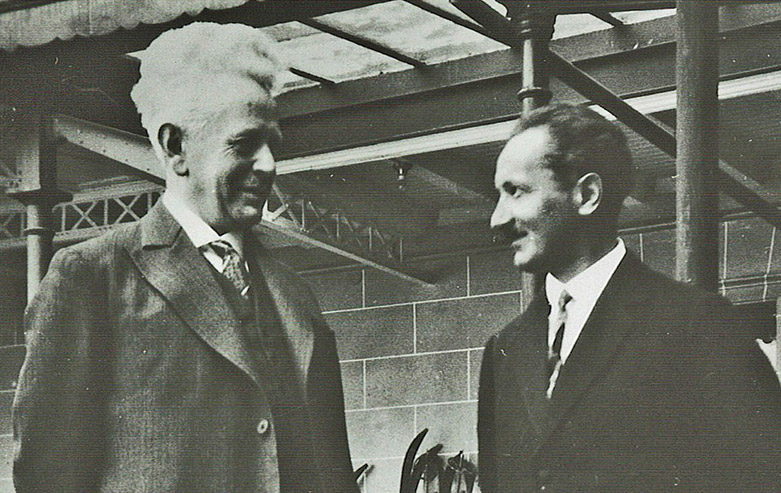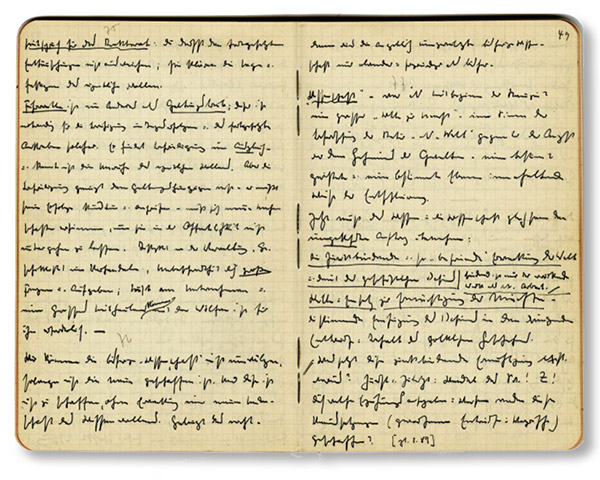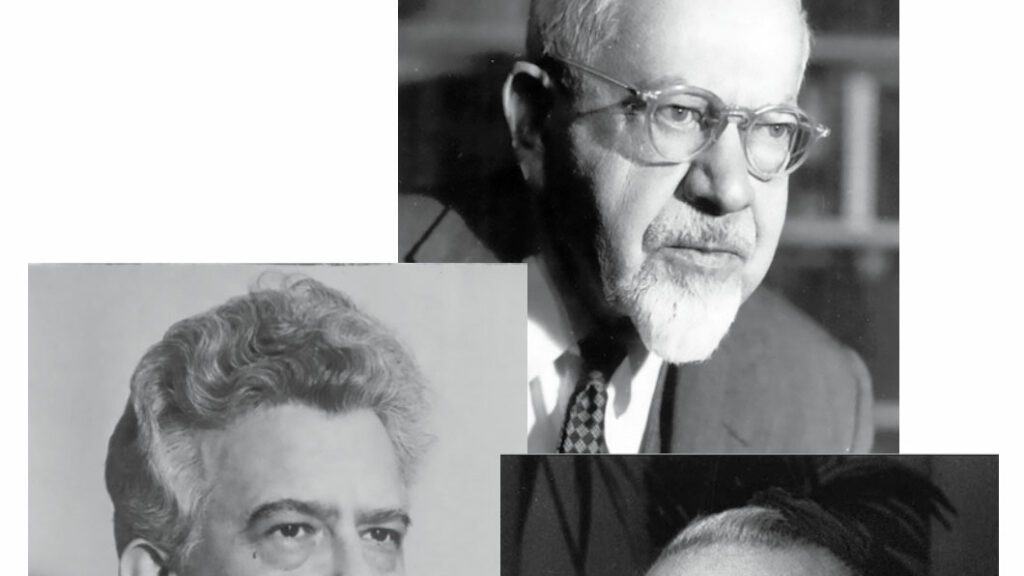Fatal Attraction
Martin Heidegger was the most divisive philosopher of the twentieth century, provoking judgments ranging from dismissive contempt to reverential admiration—with little in between. The philosopher of science Karl Popper once appealed “to the philosophers of all countries to unite and never again mention Heidegger or talk to another philosopher who defends Heidegger. This man was a devil.” By contrast, Emmanuel Levinas proclaimed that “for me, Heidegger is the greatest philosopher of the century, perhaps one of the very greatest philosophers of the millennium.” Nonetheless, Levinas devoted his intellectual life to providing an ethical, specifically Jewish corrective to what he regarded as his former teacher’s ultimately amoral and pagan philosophy.

Daniel M. Herskowitz does not avoid Heidegger’s infamous antisemitism in his brilliant new book, but his main concern is with Jewish responses like Levinas’s, which criticized the author of Being and Time from “a self-consciously Jewish standpoint.” In addition to Levinas, such critiques came from Martin Buber, Leo Strauss, and Abraham Joshua Heschel, each of which involved a complex mixture of “identification, incorporation, negotiation, critique and rejection.” Herskowitz’s comprehensive reception history underlines the astonishing fact that even after joining the Nazi Party in 1933, becoming rector of the University of Freiburg under its sponsorship, and never forthrightly repenting of the episode or, indeed, of his apparent identification of the modern curse of technology with Judaism, “no other philosopher had more impact on twentieth-century European Jewish thought than Martin Heidegger.”
In addition to the four major Jewish thinkers mentioned above, each of whom is the subject of a chapter in Heidegger and His Jewish Reception, Herskowitz shows that the German philosopher influenced an astonishingly wide array of twentieth-century Jewish philosophers, theologians, and scholars. Some were actually students of Heidegger. Another distinguished Jewish student of Heidegger, Hans Jonas, would later describe their relation to their teacher as unhealthy: “something like the relationship to the Lubavitsher [Rebbe], such as if Heidegger was a tsadik, a miracle-working rabbi, or a guru.”
The indispensable context in
which to understand the formation and resonance of Heidegger’s philosophy and
the Jewish responses to it is the intellectual crisis of the Weimar period. In
the political and economic devastation following World War I,
the rationalist, liberal-progressive presuppositions that had been ascendant
before the war gave way to cultural disillusionment and a widespread search for
more radical, existentially redemptive, and “originary” forms of thinking.
Foremost among these was Heidegger’s wholesale dismissal of all Western
metaphysics and theology since Plato and the Bible, which had led to a
disastrous “forgetfulness of Being [Sein].”
In his 1927 masterwork Being and Time, Heidegger refocused philosophical thought on an account of the finite, time-bound existence of the individual human being, or to use Heidegger’s famous term Dasein, which Heidegger described as “that entity which in its Being has this very Being as an issue.” (Dasein literally means “being there.”) This entity is “thrown” into the world and faced with the inevitability of his own death, with all the anxiety that entails, and must find an authentic way of “being-in-the-world” to live within it.
Heidegger tied these ideas to his critique of modern technology, which had turned everything into a means to an end, a set of rational calculations and actions that even transformed nature into a mere resource and occluded the real nature of Being. Despite the rather obscure language in which it was couched, Heidegger’s call to move from an “inauthentic” consciousness to an “authentic” apprehension of Being became an urgent task to a whole generation of intellectuals. As Leo Strauss would later write:
Nothing affected us as profoundly in the years in which our minds took their lasting directions as the thought of Heidegger . . . everyone else in the younger generation who had ears to hear was either completely overwhelmed by Heidegger, or else, having been almost completely overwhelmed by him, engaged in well-intentioned but ineffective rearguard actions against him.
This radical mood resulted in what was dubbed the “new thinking,” which Franz Rosenzweig had to some extent anticipated. His 1921 The Star of Redemption rejected conceptual abstractions, the imperious desire to gain knowledge of “the All,” and replaced them, as Heidegger would a few years later, with the concrete individual facing mortality. In 1929, as Rosenzweig was dying of ALS, he wrotethat Heidegger held “a philosophical position [that is] precisely our position, that of the new thinking.”
Although Herskowitz’s work deals with thinkers both seduced and disturbed by the Heideggerian vision, the vast majority of German Jews remained loyal to their liberal, progressive standpoint. Still, among concerned thinkers, these radical currents engendered a major generational shift. Nothing better illustrates the clash between the two worldviews than the now almost mythical 1929 Davos debate between Heidegger and Ernst Cassirer. While ostensibly the debate concerned their differences in interpreting Kant, what was really at stake was the question of the human essence and the nature of philosophy itself. Leaving philosophical technicalities aside, ultimately Cassirer asserted the classic liberal account of selfhood characterized by autonomy, creativity, and independence, in which objective knowledge could be attained, and moral actions could be grounded in universal principles. In contrast, Heidegger posited a subject who was inescapably situated within his own historical moment and characterized by a passive receptivity to experience, not creative spontaneity. Moreover, in his account, the meaning of existence was necessarily preconceptual and prescientific, powerfully diminishing the force and nature of human freedom.
Herskowitz correctly emphasizes the symbolically laden, extraphilosophical import of this encounter. For Heidegger, Herskowitz boldly suggests, Cassirer’s neo-Kantianism and liberal universalism were founded on a discredited metaphysical—though unstated— “Jewish” viewpoint. In effect, this was a challenge to the German Jewish vision, which conflated “Judaism with the values of the Enlightenment” and envisioned “the possibility of forming an enlightened and rational society inspired by the Jewish spirit of ethical monotheism, in which Jews are treated as equals.” In a 1929 letter to his wife, written shortly after the Davos debate, Heidegger opined:
We are faced with a choice, either to provide our German intellectual life once more with real talents and educators rooted in our own soil, or to hand over that intellectual life once and for all to the growing Jewification [Verjudung] in the broad and narrow sense.
As Hans Jonas would later remark, although Heidegger “had never expressed any political affinities or even sympathies” before joining the Nazi Party in 1933, “a certain ‘Blood-and-Soil’ point of view was always there.”

The clash between Heidegger and Cassirer also contained a certain irony. Both men regarded themselves as having transcended religion, yet each accused the other of still being burdened and impoverished by a religious sensibility and categories. For Cassirer, Heidegger’s image of individual Dasein as “world-fallenness” and its confinement to its own finitude was essentially a dark Christian view, his picture of a prevailing inauthenticity pointing to a certain “fall from grace.” Heidegger, on the other hand, regarded Cassirer’s belief in human self-creation and autonomy as an unjustified pride inherited from theology and couched in neo-Kantian philosophy.
Cassirer had a point, and a host of early Jewish interlocutors regarded the self-declared atheological Heidegger as soaked in specific Christian presuppositions regarding human existence, in particular the fallenness of man. Thus, the Jewish critic Raphael Seligmann portrayed the inherent guilt Heidegger attributed to Dasein as based on the doctrine of original sin: “I am already sinful from the very moment of my birth, and I am already guilty,” wrote Seligmann, “from the moment of my thrownness.” But, Seligmann insisted, while guilt and sin were indeed possibilities open to any person, they were outcomes of deeds, not fundamental ontological features of “being-in-the world.” (As is his wont, Herskowitz points out that Heidegger—however obscurely—posited that such “ontic” guilt was only possible on the basis of a “primordial Being-guilty.”) Interestingly, Joseph B. Soloveitchik portrayed Heidegger’s notion of “authentic existence” as secularizing not a Christian but rather a fundamentally rational Jewish notion of “self-creation as an ethical norm,” a pure idea that Heidegger had corrupted.
It is no accident that Hans Jonas wrote his famous work on gnostic theology—the early Christian heresy that pictured an unbridgeable gap between God and the sordid, fallen world in which we live—under Heidegger. His groundbreaking account of gnostic thought replicated his teacher’s existential categories (thrownness, fallenness, dread, and abandonment) in describing the gnostics’ view of “the fallen and abdicated state of human existence in a devalued world radically detached from divine transcendence.” Jonas contrasted this vision to a transcendent Jewish God who was “in no way world-negating.”
At first, Jonas didn’t recognize the similarities between his mentor and the anti-Jewish ramifications of the gnostic worldview, but in his influential 1964 lecture, “Heidegger and Theology,” Jonas insisted upon their common nihilism. The Jewish biblical God of creation valued the world, and thus, he insisted, “theology should guard the radical transcendence of God, whose voice comes not out of Being but breaks into the kingdom of Being from without.”
The remarkable variety of respondents to Heidegger and the richness of Herskowitz’s subtle analyses is occasionally lightened by some entertaining surprises, especially regarding Heidegger’s early Zionist interpreters. Herskowitz tells us that in the school year of 1931–1932, Shmuel Hugo Bergmann—who also regarded Heidegger’s thought as a form of “secularized religiosity” that lacked religion’s consolation—gave one of the first courses on Heidegger in a formal academic setting at the Hebrew University. A few years later, in a book on Chaim Nachman Bialik, Hersko-witz tells us that the liberal Zionist thinker and teacher Ernst Simon associated “Bialik’s ‘ambiguity of poetic words’ and ‘the void of nothingness, in the fear of the lonely, in the loquacious fear of death,’ from which they emerge with the existential thinking of Kierkegaard, Heidegger and Rosenzweig.”
More substantively and surprisingly, the young religious Zionist Alexander Altmann, who would later become one of the leading intellectual historians of his generation, criticized Jewish theologies of the diaspora in a Heideggerian spirit. He rejected the idea that the task of “being-Jewish-in-the-world” meant “being-Jewish-in-Exile.” In 1933, under the shadow of Nazi ascendancy, he invoked Heideggerian “national” categories (which had been only sketchily outlined in Being and Time). For Heidegger, Dasein could only exist within the framework of an inherited historical community, a Volk. “Every people,” he wrote, “has a space that belongs to it,” one that “belong[s] together with the essence and the kind of Being of a people.” Authenticity was possible only within such shared communal settings. Jews, insisted Altmann, did not share a spiritual vocation with Germans but constituted a distinct Volk with a valuable separate heritage, fate, and destiny. Writing in distinctly Heideggerian tones, Altmann declared that “The ever new way in which God addresses Israel is the Jewish destiny, which . . . legitimizes the heritage of the Torah in its totality.” He was probably unaware at the time that for Heidegger the Jews could not possibly be a true Volk: they were the incarnation of an inauthentic unattached nomadic existence, the embodiment of modernity’s cardinal sin, which was the adoption of a rationalizing technological viewpoint that made the recollection of Being impossible.
Herskowitz’s rich, exceedingly complex treatment of his central Jewish protagonists, Martin Buber, Leo Strauss, Abraham Joshua Heschel, and Emmanuel Levinas, and their engagement with Heidegger defies any effort at a quick or comprehensive summary. But one can point to the common tendencies and themes that he identifies in their writings, as well as some of the ways in which they diverged. All regarded Heidegger’s worldview as ultimately nihilistic, and they felt compelled to contend with Heidegger’s rejection of the Jewish God or any other “external and ultimate reference point that can offer a stable ground to human existence and history.” At the same time, as Herskowitz demonstrates, these thinkers often found the German thinker’s work “to be fertile ground for reconceptualizing what it means to be Jewish,” despite his troubling political history. Thus, in response to an interviewer’s characterization of him having gone “through Heidegger, beyond Heidegger, by means of Heidegger,” Levinas replied, “always with pain and suffering. But I cannot deny it. Mont Blanc is Mont Blanc.”
The first major Jewish thinker discussed is Martin Buber. Herskowitz convincingly shows that Buber never fully understood Heidegger’s philosophy. Using a term Buber himself coined, he calls their engagement a “mismeeting” (Vergegnung), a dialogue that didn’t happen. Nonetheless, Buber did identify a key issue with Heidegger’s thought: the isolated Dasein trapped in its historical moment and anxiously facing its own death doesn’t seem to be fundamentally in dialogue with any other being. There is an existential solipsism operating here, which is not really open to the deep dialogue of an “I-Thou” relationship. As his student Karl Löwith alleged, Heidegger couldn’t account for the “second person.”
Buber contrasted this putatively Greek monological philosophy with his own Jewish dialogical alternative, which drew on a kind of biblical humanism. If Heidegger’s ideal was the singular Dasein “dwelling poetically” with Being, Herskowitz characterizes
Buber’s ideal as “dwelling prophetically” in response to an ethical God and other human beings. Herskowitz’s explanation of Buber’s critique is characteristically dense, sympathetic, and trenchant:
To lay bare the difference between Heidegger’s solipsism and his own view of relational existence, Buber contrasts Dasein’s self-relating internal “call of consciousness” and primal guilt with the biblically resonant external call of “‘Where art thou?’ [Ayequa],” to which the reply is “‘Here am I’ [Hineni].” By invoking the Ayequa call, Buber implies that in Heidegger’s construal of Dasein, the exaggerated weight put on Sein leads to insufficient attendance to the actuality and specificity of Da. For him, only when I encounter—with all my being—the presence of someone who is not myself, “only then am I ‘really’ there: I am there [Ich bin da] if I am there [da], and where this ‘there’ is, is always determined less by myself than by the presence of this being which changed its form and its appearance.” Buber here covertly appropriates Heidegger’s terminology by replacing Dasein’s call with the biblical call. . . . In other words, Buber insinuates that only the relational I in its encounter with a Thou should be rightly termed “Dasein.”
Leo Strauss objected to a different aspect of Heidegger’s seemingly closed, solipsistic worldview: his historicism and relativism. The world, Strauss believed, was in need of some “enduring truth” that exceeded any particular temporal moment. “According to Strauss,” Herskowitz writes, “the overall denial of eternity and nature in Heidegger’s work results in a moral depravity that is manifested politically in the latter’s Nazism.” And yet, Strauss also resisted the temptation to reduce his teacher’s thought to his politics. This led him to conclude that the most urgent philosophical task consisted of assimilating and overcoming Heidegger. By “exposing the bankruptcy of modern philosophy and Jewish thought” (especially its various apologetic post-emancipation versions), Heidegger had also opened the back door to the possibility of a return to premodern positions of reason and faith long neglected or considered refuted.
Like Strauss, Emmanuel Levinas had a connection with Heidegger that went back to the 1920s, when he studied with him in Germany, and extended throughout his life. Their philosophical relationship is usually described in terms of Levinas’s replacement of Heideggerian ontology with the primacy of ethics. “In his early writings,” Herskowitz writes, “Levinas set out to forge an alternative to the Heideggerian being-in-the-world by formalizing the experience of being-Jewish into a modality of existence, thereby challenging the claim for exclusivity of Heidegger’s analysis of Dasein.” Heidegger’s descent into Nazism and totalitarianism’s homogenous fantasy showed the primal necessity of responding to the “other.” Levinas’s human being is not only thrown into a world he did not make, he is confronted before all else with “the face of the other” and the infinite moral obligation that confrontation imposes upon him. Levinas increasingly turned to biblical texts and rabbinic tradition to develop a Jewish corrective to what he regarded as Heidegger’s paganism. The “formal structures of Judaism, understood phenomenologically and hence, following Heidegger’s footsteps, ontologized, universalized, and secularized,” served as an appropriate philosophical rejoinder, a more legitimate alternative to the plight of the West which Heidegger had first articulated.
Abraham Joshua Heschel also had an ongoing, if more sporadic, concern with Heidegger’s thought, culminating in his 1963 lectures at Stanford that became the small book Who Is Man? “The fundamental assumption with which Heschel approaches Heidegger,” Herskowitz argues, “is that ‘the problem of being can never be treated in isolation but only in relation to God.’” Accepting the Heideggerian position that “a key element of human existence” consists in “the fundamental distress of existential alienation and misplacement,” Heschel redirected this sense of homelessness as the reflection of “an embedded existential urge toward a relation with what is beyond”—the personal God of the Hebrew Bible. Thus, like Buber and Levinas, Heschel argued that Heidegger’s analysis of the existential predicament was too solipsistic; the human being must be understood in relation to something radically other than itself. “There is a care that hovers over beings,” Heschel wrote. “Being is surpassed by concern for being. Being would cease to be were it not for God’s care for Being.”
In sum, Heidegger’s principal Jewish interlocutors accepted the depth of his analysis while positing a distinctively Jewish corrective to his philosophy. Indeed, if the German philosopher raged in his notebooks against the “Judaization” of the modern world, his Jewish interpreters insisted that it was precisely in Judaism, properly understood, that the solution to the problems of modernity lay. As Herskowitz writes, for his Jewish critics, Heidegger represented:
irrationalism in a world in need of rational order; a godless worldview in a world in need of God; the monological existence in a world in need of dialogue; the totalitarianism of the Same in a world in need of respect for otherness; historicism and relativism in a world in need of enduring truth; world-denial in a world in need of world-affirmation; or the paganism of a disinterested deity in a world in need of divine care.
Herskowitz’s treatment of these complex engagements is intriguing. He does not take sides. Indeed, he is quick to point out where he believes Heidegger’s Jewish critics (Buber and Heschel in particular) have misunderstood him. He never shies away from the fact of Heidegger’s active endorsement of National Socialism, yet he also shows that in his Jewish reception, Heidegger’s philosophy was “never completely contracted to his politics.” Importantly, he stresses that the static dichotomies shared by both Heidegger and his critics were often too simplistic. The self-serving polarities between “German” and “Jew,” “Athens” and “Jerusalem,” the “poetic” and the “prophetic,” the “monological” and the “dialogical” that characterized these engagements cannot ultimately withstand critical analysis. There was something also fruitless about the shared search in all these thinkers for hallowed origins. As the gadfly scholar Jacob Taubes commented regarding both Buber’s biblical monotheism and Heidegger’s fascination with pre-Socratics: “Why the early should be better than the later, I simply don’t understand.”

Herskowitz’s saga takes place in twentieth-century Europe. What of Heidegger’s Jewish reception in the twenty-first century? And how much has been changed by the shocking recent revelations contained in Heidegger’s long-withheld Black Notebooks, which make a mockery of decades of queasy apologetics? In Jewry’s darkest possible hours, he proclaimed that “World Judaism” (Weltjudentum) was “the sort of human singularity which, being utterly unattached, can undertake the uprooting of all beings from being as world-historical mission.” Even after he became disillusioned with National Socialism, he continued to portray Judaism as incarnating the principle of destruction and, bizarrely, regarded biblical monotheism as the origin of the Nazi urge toward violent domination. Most scandalously, he implied that Nazi persecution of the Jews was actually a kind of Jewish self-annihilation:
When the essentially “Jewish” in the metaphysical sense comes to combat the Jewish, the high point of self-annihilation in history has arrived—supposing that the “Jewish” has everywhere completely seized mastery for itself, so that even the fight against “the Jewish,” and it above all, becomes subject to it.
Yet, despite these revelations, the Jewish Heideggerian temptation remains alive and well in the twenty-first century. To be sure, its proponents are no longer European but rather Anglo-American and Israeli thinkers writing in radically different circumstances and shaped by a postmodern sensibility. It is not as if these intellectuals are unaware of Heidegger’s Nazism and his later-reported notorious comments. They all both acknowledge and reject Heidegger’s virulent antisemitism, and their work consists of highly sophisticated, occasionally deep readings of his work. Yet unlike their twentieth-century counterparts, they do not write in opposition to Heidegger or in order to supplement his thought in distinctively Judaic ways. Rather they find in it the positive “other” in Western thought whose radical critique of domination and “usefulness” is said to resonate with certain forms of Jewish thought.
In their different ways, these scholars and philosophers discover and excavate what they take to be affinities and conceptual correspondences, counternuggets and clusters of Heideggerian thought that do not conform to the idioms of mastery and control supposedly inherent in Western philosophy. Such insights are held to deepen and illuminate—as well as critique—Zionism (as in the ruminations of Michael Fagenblat), Jewish mysticism (see, especially, the ongoing work of Elliot R. Wolfson), and even talmudic Judaism (as roughly sketched by Elad Lapidot). Heidegger, it appears, will be attractive as long as technological mass society seems to overwhelm the human spirit. However, unlike the works of Buber, Heschel, Levinas, and Strauss, it is doubtful that the often obscure writings of these twenty-first-century Heideggerians are likely to herald revolutionary shifts of Jewish consciousness and thought.
Emerging out of these dense forests, one can be forgiven for longing for a ray of Cassirer’s liberal Kantian light.
Suggested Reading
National Socialism, World Jewry, and the History of Being: Heidegger’s Black Notebooks
The thinking reflected in Heidegger's recently published notebooks from the 1930s is alarmingly crude. It is also much more difficult to separate from his philosophy than many would like to think.
Michael Wyschogrod and the Challenge of God’s Scandalous Love
The late Michael Wyschogrod may have been the boldest Jewish theologian of the 20th century.

Between Literalism and Liberalism
While literalism is intellectually untenable and liberalism is numerically imperiled, many Jews find that what they believe cannot be transmitted, and what can be effectively transmitted they cannot believe.
Eichmann, Arendt, and “The Banality of Evil”
Richard Wolin’s review of a new book about Adolf Eichmann caused a stir, mainly about Arendt. His exchange with Seyla Benhabib on the banality (or not) of evil.
Comments
You must log in to comment Log In